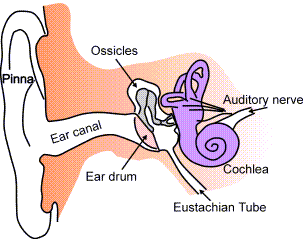|
OTIC (OH-tik)
Of,
pertaining to, or near the ear
Common
clues: Of the ear; Ear-related; Auricular; Auditory; Pertaining
to the ear; Hearing related; Aural; Eary?; Of hearing
Crossword
puzzle frequency:
3 times a year
News:
KISS
Vocalist Urges Teens to Turn Down the Music
Video:
The
Hearing Ear
Happy
is the hearing man; unhappy the speaking man.
– Ralph Waldo Emerson
An
ear
is an organ used by
an animal to detect sound. The term may refer to the entire
system responsible for collection and early processing of sound
(the beginning of the auditory system), or merely the
externally-visible part. Not all animals have ears in the same
part of the body.
Mammals,
including humans, have two ears, one on each side of the head.
The
outer
ear is
the external portion of the ear. The visible part is called the
pinna, or auricle, and functions to collect and focus sound
waves. Many mammals can move the pinna in order to focus their
hearing in a certain direction, in much the same way that they
can turn their eyes. Humans have generally lost this ability.
From the pinna, the sound pressure waves move into the ear canal,
a simple tube running to the middle ear. This tube amplifies
frequencies in the range 3 kHz to 12 kHz.

The
middle
ear includes
the eardrum (tympanum or tympanic membrane) and the ossicles,
three tiny bones of the middle ear. Their Latin names are the
malleus, incus, and stapes, but they are also referred to by
their English translations: the hammer,
anvil,
and stirrup
respectively.
The
middle ear is hollow. If the animal moves to a high-altitude
environment, or dives into the water, there will be a pressure
difference between the middle ear and the outside environment.
This pressure will pose a risk of bursting or otherwise damaging
the tympanum if it is not relieved. This is one of the functions
of the Eustachian tubes - evolutionary descendants of the gills -
which connect the middle ear to the nasopharynx. The Eustachian
tubes are normally pinched off at the nose end, to prevent being
clogged with phlegm, but they may be opened by lowering and
protruding the jaw; this is why yawning helps relieve the
pressure felt in the ears when on board an aircraft.
The
inner
ear comprises
both the organ of hearing (the cochlea) and the labyrinth or
vestibular apparatus, the organ of balance located in the inner
ear that consists of three semicircular canals and the vestibule.
This
article is licensed under the GNU
Free Documentation License.
It uses material from the Wikipedia
article "Ear".
52
Tu+ >1 08 Of the ear
29
Tu+ >1 06 Ear-related
27
We- >1 06 Auricular
12
We+ >1 03 Auditory
9
We- >1 07 Suffix with psych- OSIS
8
Tu >1 09 Psych final? OSIS
5
We LAT 03 Ending for psych
4
Tu >1 08 Pertaining to the ear
3
We+ >1 08 Hearing-related
3
Th+ LAT 08 Psych ending OSIS
3
Th+ NYT 06 Suffix with neur-
2
Tu- >1 98 Relating to the ear
2
Tu >1 84 Of hearing
2
We- NYT 08 Suffix with hypn-
2
We >1 09 Suffix with narc
2
Th- >1 07 Connected to the ear
2
Th Rea 08 Psych finish OSIS
2
Th LAT 02 Narc chaser? OSIS
2
Th Rea 00 Eary?
2
Fr- LAT 05 Narc ending
2
Fr- >1 87 Aural
1
Mo LAT 96 Of the ears
1
Mo LAT 96 On the ear: comb. form
1
Tu NYT 97 Suffix with psych- or neur-
1
We LAT 08 Psych suffix OSIS
|